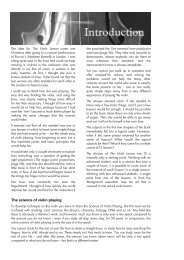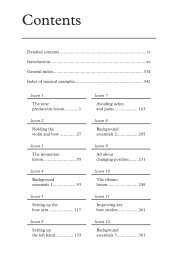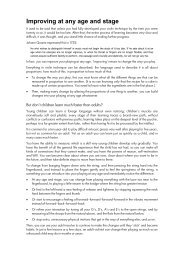Muscles: working from the zero point - Simon Fischer
Muscles: working from the zero point - Simon Fischer
Muscles: working from the zero point - Simon Fischer
You also want an ePaper? Increase the reach of your titles
YUMPU automatically turns print PDFs into web optimized ePapers that Google loves.
<strong>Muscles</strong>: <strong>working</strong> <strong>from</strong> <strong>the</strong> <strong>zero</strong> <strong>point</strong><br />
Key <strong>point</strong>: Spreading <strong>the</strong> fingers is one thing; tightening is ano<strong>the</strong>r. They are two separate factors. After<br />
only a short time of playing double stops with a tight hand, when we first attempt <strong>the</strong>m as beginners,<br />
we form an association between tension and double stops and forever afterwards expect that feeling.<br />
Instead, picture <strong>the</strong> hand remaining soft, flexible and free as you widen it. Then find this feeling of<br />
letting go, releasing and remaining free as you widen <strong>the</strong> fingers.<br />
It is perfectly possible to widen <strong>the</strong> hand a long way and remain soft and free at <strong>the</strong> same time. You just<br />
have to break <strong>the</strong> association with tension, and begin to expect softness and freedom ra<strong>the</strong>r than<br />
contraction and hardness.<br />
Fig. 102 (a) Release every muscle in <strong>the</strong><br />
hand [xxx]<br />
Leng<strong>the</strong>ning and widening<br />
Leng<strong>the</strong>ning <strong>the</strong> back and neck<br />
(b)Widening <strong>the</strong> fingers as though playing a minor third<br />
Since muscles can only contract, undoing bad habits of posture usually involves leng<strong>the</strong>ning <strong>the</strong><br />
muscles, as well as finding <strong>the</strong> middle <strong>point</strong> where a muscle is nei<strong>the</strong>r contracted nor stretched.<br />
Suppose you notice in <strong>the</strong> mirror that your shoulders seem too rounded (Fig. 103a). The top of <strong>the</strong><br />
chest is pulled down; notice <strong>the</strong> chin jutting out and <strong>the</strong> back of <strong>the</strong> head pulled down.<br />
So, using <strong>the</strong> muscles around your shoulder blades, you pull your shoulders back, leaving everything<br />
else as it was before (Fig. 103b). Of course if you were to do this it would cause great strain. The<br />
position in <strong>the</strong> photograph is exaggerated to illustrate <strong>the</strong> <strong>point</strong>; but many people do an imperceptible<br />
amount of pulling back, which creates great tension.<br />
Instead, <strong>the</strong> answer to <strong>the</strong> rounded shoulders is to leng<strong>the</strong>n <strong>the</strong> back (Fig. 103c). The shoulders <strong>the</strong>n<br />
naturally want to ease back into <strong>the</strong>ir correct position. Then, because <strong>the</strong> spine is more upright, <strong>the</strong><br />
head naturally finds a position of balance where it can just sit on top of <strong>the</strong> spine.<br />
Key <strong>point</strong>: If you pull down in <strong>the</strong> upper chest, your head is right to want to go into <strong>the</strong> position shown<br />
in Fig. 103b, since that is actually ‘correct’ for <strong>the</strong> head, given <strong>the</strong> position of <strong>the</strong> back.<br />
If <strong>the</strong> back leng<strong>the</strong>ns, and finds more of an upright position of balance, <strong>the</strong> best position of balance for<br />
<strong>the</strong> head naturally changes too.<br />
(a) Pulling down, rounded<br />
shoulders, head back and down<br />
Fig. 103 (a) Pulling down [xxx]<br />
(b) Same plus pulling back<br />
shoulders<br />
(b) Pulling <strong>the</strong> shoulders back does not<br />
help [xxx]<br />
(c) Description text<br />
(c) The shoulders naturally ease back when<br />
you leng<strong>the</strong>n and widen [xxx]<br />
[v5.1 12/06/2010 2:10 PM] Lesson 7: Avoiding aches and pains 193






